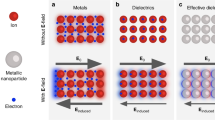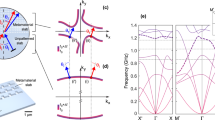Abstract
The law of refraction first derived by Snellius and later introduced as the Huygens–Fermat principle1, states that the incidence and refracted angles of a light wave at the interface of two different materials are related to the ratio of the refractive indices in each medium. Whereas all natural materials have a positive refractive index and therefore exhibit refraction in the positive direction, artificially engineered negative index metamaterials have been shown capable of bending light waves negatively2,3,4,5,6,7,8. Such a negative refractive index is the key to achieving a perfect lens that is capable of imaging well below the diffraction limit9,10,11. However, negative index metamaterials are typically lossy, narrow band, and require complicated fabrication processes. Recently, an alternative approach to obtain negative refraction from a very thin nonlinear film has been proposed12,13 and experimentally demonstrated in the microwave region14,15,16. However, such approaches use phase conjugation, which makes optical implementations difficult. Here, we report a simple but different scheme to demonstrate experimentally nonlinear negative refraction at optical frequencies using four-wave mixing in nanostructured metal films. The refractive index can be designed at will by simply tuning the wavelengths of the interacting waves, which could have potential impact on many important applications, such as superlens imaging.
This is a preview of subscription content, access via your institution
Access options
Subscribe to this journal
Receive 12 print issues and online access
$259.00 per year
only $21.58 per issue
Buy this article
- Purchase on Springer Link
- Instant access to full article PDF
Prices may be subject to local taxes which are calculated during checkout





Similar content being viewed by others
References
Huygens, C. Traité de la Lumiere (Pieter van der Aa, 1690).
Shelby, R. A., Smith, D. R. & Schultz, S. Experimental verification of a negative index of refraction. Science 292, 77–79 (2001).
Lezec, H. J., Dionne, J. A. & Atwater, H. A. Negative refraction at visible frequencies. Science 316, 430–432 (2007).
Valentine, J. et al. Three-dimensional optical metamaterial with a negative refractive index. Nature 455, 376–379 (2008).
Zhang, S. et al. Experimental demonstration of near-infrared negative-index metamaterials. Phys. Rev. Lett. 95, 137404 (2005).
Shalaev, V. M. et al. Negative index of refraction in optical metamaterials. Opt. Lett. 30, 3356–3358 (2005).
Dolling, G., Enkrich, C., Wegener, M., Soukoulis, C. M. & Linden, S. Simultaneous negative phase and group velocity of light in a metamaterial. Science 312, 892–894 (2006).
Soukoulis, C. M., Linden, S. & Wegener, M. Negative refractive index at optical wavelengths. Science 315, 47–49 (2007).
Pendry, J. B. Negative refraction makes a perfect lens. Phys. Rev. Lett. 85, 3966–3969 (2000).
Fang, N., Lee, H., Sun, C. & Zhang, X. Sub-diffraction-limited optical imaging with a silver superlens. Science 308, 534–537 (2005).
Taubner, T., Korobkin, D., Urzhumov, Y., Shvets, G. & Hillenbrand, R. Near-field microscopy through a SiC superlens. Science 313, 1595–1595 (2006).
Maslovski, S. & Tretyakov, S. Phase conjugation and perfect lensing. J. Appl. Phys. 94, 4241–4243 (2003).
Pendry, J. B. Time reversal and negative refraction. Science 322, 71–73 (2008).
Allen, C. A., Leong, K. M. K. H. & Itoh, T. A negative reflective/refractive meta-interface using a bi-directional phase-conjugating array. IEEE Int. Microw. Theory Tech. Symp. Dig. 3, 1875–1878 (2003).
Fusco, V. F. et al. Active phase conjugating lens with sub-wavelength resolution capability. IEEE Trans. Antennas Propag. 58, 798–808 (2010).
Katko, A. R. et al. Phase conjugation and negative refraction using nonlinar active metamaterials. Phys. Rev. Lett. 105, 123905 (2010).
Bloembergen, N. & Pershan, P. S. Light waves at the boundary of nonlinear media. Phys. Rev. 128, 606–622 (1962).
Boyd, R. W. et al. (eds) Nonlinear Optics (Academic, 2003).
Bartal, G., Manela, O. & Segev, M. Spatial four wave mixing in nonlinear periodic structures. Phys. Rev. Lett. 97, 073906 (2006).
Smith, D. D. et al. z-scan measurement of the nonlinear absorption of a thin gold film. J. Appl. Phys. 86, 6200–6205 (1999).
Klein, M. W., Enkrich, C., Wegener, M. & Linden, S. Second-harmonic generation from magnetic metamaterials. Science 313, 502–504 (2006).
Renger, J., Quidant, R., van Hulst, N. & Novotny, L. Surface-enhanced nonlinear four-wave mixing. Phys. Rev. Lett. 104, 046803 (2010).
Su, K. H., Wei, Q. H. & Zhang, X. Tunable and augmented plasmon resonances of Au/SiO2/Au nanodisks. Appl. Phys. Lett. 88, 063118 (2006).
Palomba, S. & Novotny, L. Nonlinear excitation of surface plasmon polaritons by four-wave mixing. Phys. Rev. Lett. 101, 056802 (2008).
Maier, S. A. et al. Local detection of electromagnetic energy transport below the diffraction limit in metal nanoparticle plasmon waveguides. Nature Mater. 2, 229–232 (2003).
Acknowledgements
The authors acknowledge funding support from the US Army Research Office (MURI W911NF-09-1-0539).
Author information
Authors and Affiliations
Contributions
S.P. conducted the measurements. S.P. and S.Z. performed numerical simulations. Y.P. fabricated the samples. S.P., G.B., X.Y., S.Z. and X.Z. analysed the experimental data and wrote the manuscript. X.Z., X.Y. and G.B. guided the research. All authors contributed to discussions.
Corresponding author
Ethics declarations
Competing interests
The authors declare no competing financial interests.
Rights and permissions
About this article
Cite this article
Palomba, S., Zhang, S., Park, Y. et al. Optical negative refraction by four-wave mixing in thin metallic nanostructures. Nature Mater 11, 34–38 (2012). https://doi.org/10.1038/nmat3148
Received:
Accepted:
Published:
Issue Date:
DOI: https://doi.org/10.1038/nmat3148
This article is cited by
-
Wavefront shaping with nonlinear four-wave mixing
Scientific Reports (2023)
-
Effects of Self-Phase and Cross-Phase Modulations at Four-Wave Mixing in Optical Fibers
Journal of Russian Laser Research (2022)
-
Nonlinear meta-optics towards applications
PhotoniX (2021)
-
Four-Wave Mixing in Metamaterials
Russian Physics Journal (2019)
-
Negative refraction based on purely imaginary metamaterials
Frontiers of Physics (2018)



